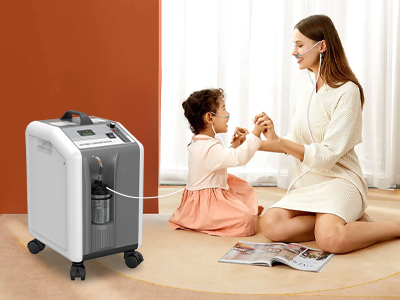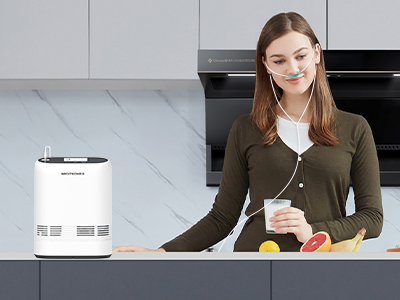14 Jun 2024
Home oxygen therapy involves the use of a device to deliver oxygen to patients at higher concentrations than ambient air. It is typically prescribed for those who suffer from chronic obstructive pulmonary disease (COPD), pulmonary fibrosis, heart failure, and other conditions that impair lung function.
Several medical conditions necessitate the use of oxygen therapy. COPD, which includes emphysema and chronic bronchitis, is one of the most common. Other conditions include severe asthma, interstitial lung disease, and complications from heart disease. These ailments often reduce the lungs' ability to absorb oxygen, leading to hypoxemia, which can cause fatigue, confusion, and breathlessness.

Benefits of Home Oxygen Therapy
A. Improved Quality of Life
One of the primary benefits of home oxygen therapy is an improved quality of life. Patients often experience significant relief from symptoms such as shortness of breath, allowing them to engage in daily activities with greater ease and comfort. This improvement can lead to a more active and fulfilling lifestyle.
B. Enhanced Physical Activity
With adequate oxygenation, patients can increase their level of physical activity. This can range from simple tasks like walking and climbing stairs to more intensive exercises. Enhanced physical activity helps in maintaining muscle strength, reducing the risk of complications, and improving overall health.
C. Better Sleep and Mental Health
Supplemental oxygen can improve sleep quality by ensuring that the body receives enough oxygen throughout the night. This can lead to better mental clarity, reduced anxiety, and overall emotional well-being. Patients often report feeling more rested and alert during the day.
Types of Home Oxygen Therapy Systems
A. Oxygen Concentrators
Oxygen concentrators are the most common type of home oxygen therapy system. They work by extracting oxygen from the surrounding air and delivering it to the patient in concentrated form. These devices are available in both stationary and portable models, making them suitable for use at home and on the go.
B. Compressed Gas Cylinders
Compressed gas cylinders store oxygen in a high-pressure tank. They are typically used for short-term or intermittent oxygen therapy. These cylinders are portable and can be used as a backup to oxygen concentrators, especially during power outages or when traveling.
C. Liquid Oxygen Systems
Liquid oxygen systems store oxygen in its liquid form, which allows for a larger volume of oxygen to be stored in a smaller space. These systems are ideal for patients who require high-flow oxygen. They are more compact and portable than gas cylinders, making them a good option for active individuals.
Setting Up Home Oxygen Therapy
A. Choosing the Right Equipment
It is essential to consult with healthcare providers to determine the best system. Factors to consider include oxygen flow rate requirements, portability, and ease of use.
B. Installation and Safety Precautions
Ensure that the equipment is placed in a well-ventilated area, away from heat sources and flammable materials. Patients should receive training on how to use the equipment correctly and what safety precautions to follow.

Daily Use and Maintenance
A. Using Oxygen Therapy Correctly
Daily use of home oxygen therapy involves setting up the equipment according to the prescribed flow rate, wearing the oxygen delivery device (such as a nasal cannula or mask), and monitoring oxygen levels. It is important to follow the doctor's instructions carefully to achieve the best outcomes.
B. Regular Maintenance and Troubleshooting
Regular maintenance of oxygen therapy equipment includes cleaning filters, checking for leaks, and ensuring that the device is functioning correctly. Patients should be familiar with basic troubleshooting techniques and know when to seek professional help if issues arise.
Overcoming Challenges
A. Mobility and Travel Considerations
Mobility can be a challenge for patients using oxygen therapy. Portable oxygen concentrators and lightweight cylinders can help patients maintain their independence and continue participating in social activities. When traveling, it is essential to plan ahead, inform airlines, and ensure that the necessary equipment and prescriptions are available.
B. Social and Psychological Adaptations
Using oxygen therapy can have social and psychological impacts. Patients may feel self-conscious or anxious about using the equipment in public. Support groups, counseling, and education can help patients and their families adapt to these changes and maintain a positive outlook.
Frequently Asked Questions
A. How Long Can I Use Oxygen Therapy?
The duration of oxygen therapy varies depending on the patient's condition and needs. Some patients may require oxygen therapy only during activities or sleep, while others may need it continuously. It is essential to follow the healthcare provider's recommendations.
B. Can I Travel with Oxygen Therapy?
Yes, patients can travel with oxygen therapy. Portable oxygen concentrators approved by the FAA can be used on airplanes. Patients should inform airlines in advance and ensure that they have enough oxygen supplies for the entire trip.
C. What Should I Do in Case of Equipment Failure?
In case of equipment failure, patients should have a backup plan in place, such as spare oxygen cylinders or a portable concentrator. It is also crucial to contact the equipment provider or healthcare professional immediately for assistance.
Conclusion
A. Recap of Key Points
Home oxygen therapy is a vital treatment for individuals with chronic respiratory conditions. It improves quality of life, enhances physical activity, and supports better sleep and mental health. Understanding the different types of systems, how to set up and maintain the equipment, and overcoming challenges are essential for effective therapy.
B. Encouragement for Those Considering Home Oxygen Therapy
For those considering home oxygen therapy, it is important to consult with healthcare providers, stay informed about your condition, and utilize available resources. With proper support and management, home oxygen therapy can lead to a more active and fulfilling life.
Keywords: oxygen therapy
Originally published 14 Jun 2024, updated 14 Jun 2024.